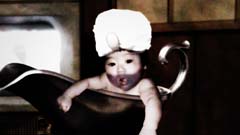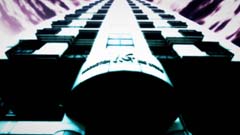Interview with Mamoru Oshii - Part III
The Potential for Mockumentaries and Superlivemation
 | Mamoru Oshii Born in Tokyo on August 8, 1951, Mamoru Oshii is one of the most remarkable personalities in modern Japanese filmmaking. He introduced introspective philosophical speculation into the world of animation, influencing at the same time movie creators all around the globe with his visionary style. Oshii joined the animation industry in 1977. His main works are Urusei Yatsura 2: Beautiful Dreamer (1984) the epoch-making Ghost in the Shell (1995) and Innocence (2004, nominated for the Palme d'Or at the Festival de Cannes). Oshii has also directed a number of live-action features, including Avalon (2001). Tachigui: The Amazing Lives of the Fast Food Grifters , based on his own novel, released in Japan on April 8, 2006, had its international premiere at the 63rd Venice Film Festival. |
In Tachigui, you used a production technique known as superlivemation, which can be described as a natural evolution of what you first used in MiniPato.
Well, the thought just occurred to me when it was decided to go forward with the production of this movie. I thought it was the perfect project for trying out this technique. I figured that if I didn't seize on the opportunity then, I might have to wait several more years.
Do you see this as a special kind of film?
Of course I do (laughs)! Moreover, you could say that it was precisely because this work was special that they let me film it this way. If I had said that I wanted to do Patlabor or Avalon with a paper puppet-style, it would have not worked at all. Rather, you need to use special techniques in order to create a special film. When you take up a thematic challenge, then, at the same time, you would generally want to take up a technical challenge too. If you want to produce a conventional type of drama, you would hardly do it into animation. So, when you think that you want to do something different, it's only the production techniques that come to mind.
Did you see filming Tachigui as a unique process?
Of course it was. There is no other film like that out there. I wanted to do a documentary, but with a little cheating here and there. Tachigui would be regarded as a feature film, but to me it is very much a documentary. It's best to say that it is in a "documentary form." There's a narrator and historical figures speaking. And there's historical footage to support what's spoken. Mind you, all of that was made up as well (laughs). The rest is to sprinkle a few real historical facts among what's being said about a historical episode. So, what happens when you put all this together? Simply that you realize that there's not much difference between the fictitious and the factual bits. In that sense, this film is special.
In terms of technique, I'm sure there were many new challenges as well.
There were no particular difficulties. Casting, choosing locations, compositing, digital graphics, and recording the music and narration, it all generally went smoothly. But taking the stills was much harder than I had imagined. It seriously took a lot of effort, and there really was no time to rest. When you're doing live action, there's usually a lot of time where you're just waiting around, but there was no slack time in this case. All we would need were a bunch of shots taken against blue backs, but we had to have maybe three actors in costume standing by for this. That was the most exhausting shooting I'd ever done.

Do you shoot the stills while referencing the storyboard?
Not at all. After all, the one doing the shooting is also the one who did the storyboard. So I already have it all in my head. It would be strange if I didn't have practically every cut in my head anyway. And that's not just with this particular job; even when I'm working on anime, I rarely ever look at the storyboard. I don't walk around with it. Well, there are times when I forget things... (laughs). When that happens, I turn to the person next to me and ask to take a peek.
Did you ever find that you didn't have enough material after the shoot?
We did do some additional shooting afterwards. But that was usually because we weren't able to obtain a still that we thought we'd be able to get. We had a girl from the studio rush out and buy hamburgers and take some shots of it right there on the spot. And also in the Medium Hot Sabu segment, we actually intended to borrow a picture of Shoji Kawamori when he was a student. But it was taking him forever to send that picture along to us, so I approached Kifune-san (*), and said, "You have a son, don't you? Do you have a picture of him?" He said he had more than he could shake a stick at. So we borrowed a picture of his son as an infant, and we colored the area around his mouth blue.

That was Kifune-san's son?!
There he was saying, "This is Shozaburo Kawamori!" (laughs) I mean, I was embarrassed with the pictures of me from my student days. I really hate showing pictures like that to people. And I find pictures from that time to be kind of funny. The flavor of that period is just so obvious. Everyone has longish hair and is wearing flared jeans. I don't think there's a period that experienced a more embarrassing fashion scene then those times. We adopted a fashion sense that was least suited to Japanese people. That's exactly why I wanted to get one of those shots, but since it looked like Kawamori wasn't going to give me one, I thought I'd borrow a picture of Mitsuhisa Ishikawa (**) from his vagabond days. But then he said he never had a picture of himself from that period. I thought to myself, "Why, of course." (laughs).
Have you thought about doing another project using the same technique?
I have. If they'll let me, that is. But I don't really think that I want to do another documentary. I want to do it for a dramatic feature film. If I were to do that, I think it would be different again. Even using the same technique, there are more elaborate ways to apply it. But this would make the whole process far more complicated than simply shooting photos.
Do you see the potential in this technique?
Yes. And perhaps it might even directly lead to the development of new products. I'm thinking of these things quite seriously. Character design these days has reached its limit whether it is live action or anime. I think this technique can open up some big possibilities and lead to a breakthrough.
In recent Hollywood-made live action movies, it has become problematic to determine what part of a character's movements depends on the actor's performance and what part of it is the result of digital animation.
So the era of movie stars may be coming to an end. But I don't think that 3D characters in digital animation are going to take their places. No matter how minute you make the body movements, it'll still always give the impression of a "moving corpse." How life-like a character appears isn't a matter of being able to "see the blood coursing beneath the skin surface." Anybody working in animation would know that when you put a voice to a character and make its eyes blinking three times, you can get an excellent life-like impression. But you don't get a life-like effect by simply adding more data to a 3D rendering. In that sense, this paper puppet-like style is much better at conveying "animation."
(3 - end)
(*) Tokumitsu Kifune is the Digital Graphics Engineer for this project. He and his wife Sonoko Ishida form the unit known as IKIF.
(**) Mitsuhisa Ishikawa, President and CEO of Production I.G, stars in the movie as Crying Inumaru, but his personal background, especially his vagabond life abroad, was actually used as model for Medium Hot Sabu. One should not miss the following lines, said while the camera takes an unnaturally huge Production I.G building: "Incidentally, many youngsters left Japan during the period of rapid economic growth to travel in Asia, Africa and the Middle East. Some of them, strangely enough, ended up founding anime studios."

This interview was originally collected in Japanese by Shotaro Miya
© 2006 MAMORU OSHII, Production I.G / TACHIGUISHI RETSUDEN Committee

![WORK LIST[DETAILS]](/contents/works/design/images/left_title.gif)



 terms of use
terms of use